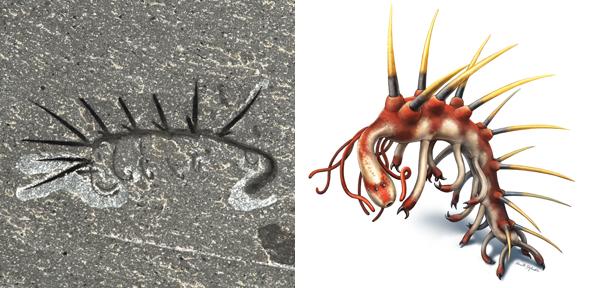| Online: | |
| Visits: | |
| Stories: |

| Story Views | |
| Now: | |
| Last Hour: | |
| Last 24 Hours: | |
| Total: | |
Hallucigenia: One of the Most Bizarre Creatures Ever Discovered
A new study of an otherworldly creature from half a billion years ago – a worm-like animal with legs, spikes and a head difficult to distinguish from its tail – has definitively identified its head for the first time, and revealed a previously unknown ring of teeth and a pair of simple eyes.
Credit: Left: Jean-Bernard Caron Right: Danielle Dufault
“Prior to our study there was still some uncertainty as to which end of the animal represented the head, and which the tail,” said Smith. “A large balloon-like orb at one end of the specimen was originally thought to be the head, but we can now demonstrate that this actually wasn’t part of the body at all, but a dark stain representing decay fluids or gut contents that oozed out as the animal was flattened during burial.”
Identifying this end as the tail led Caron to revisit the fossils and dig away the sediment that was covering the head: the animals died as they were buried in a mudslide, and their floppy head often ended up pointing down into the mud. “This let us get the new images of the head,” said Caron.
“When we put the fossils in the electron microscope, we were initially hoping that we might find eyes, and were astonished when we also found the teeth smiling back at us!” The new images show an elongated head with a pair of simple eyes, which sat above a mouth with a ring of teeth.
In addition, Hallucigenia’s throat was lined with needle-shaped teeth. The fossils originated in the Burgess Shale of Yoho National Park in western Canada, one of the world’s richest sources of fossils from the Cambrian period.
The ring of teeth that surrounded Hallucigenia’s mouth probably helped to generate suction, flexing in and out, like a valve or a plunger, in order to suck its food into its throat. The researchers speculate that the teeth in the throat worked like a ratchet, keeping food from slipping out of the mouth each time it took another ‘suck’ at its food. “These teeth resemble those we see in many early moulting animals, suggesting that a tooth-lined throat was present in a common ancestor,” said Caron.
“So where previously there was little reason to think that arthropod mouths had much in common with the mouths of animals such as penis worms, Hallucigenia tells us that arthropods and velvet worms did ancestrally have round-the-mouth plates and down-the-throat teeth – they just lost or simplified them later.” The material for this study was collected between 1992 and 2000 and represents more than 165 additional Hallucigenia specimens – including many rare orientations and well-preserved specimens.
Parks Canada, which holds jurisdiction over the Burgess Shale sites located in Yoho and Kootenay national parks, is thrilled by this discovery and eager to share this exciting new piece of the ever-unfolding Burgess Shale story with their visitors. The research was funded by Clare College, Cambridge, the Natural Sciences and Engineering Research Council of Canada, and the Royal Ontario Museum.
Contacts and sources:
Sarah Collins
University of Cambridge
Source: http://www.ineffableisland.com/2015/07/hallucigenia-one-of-most-bizarre.html




